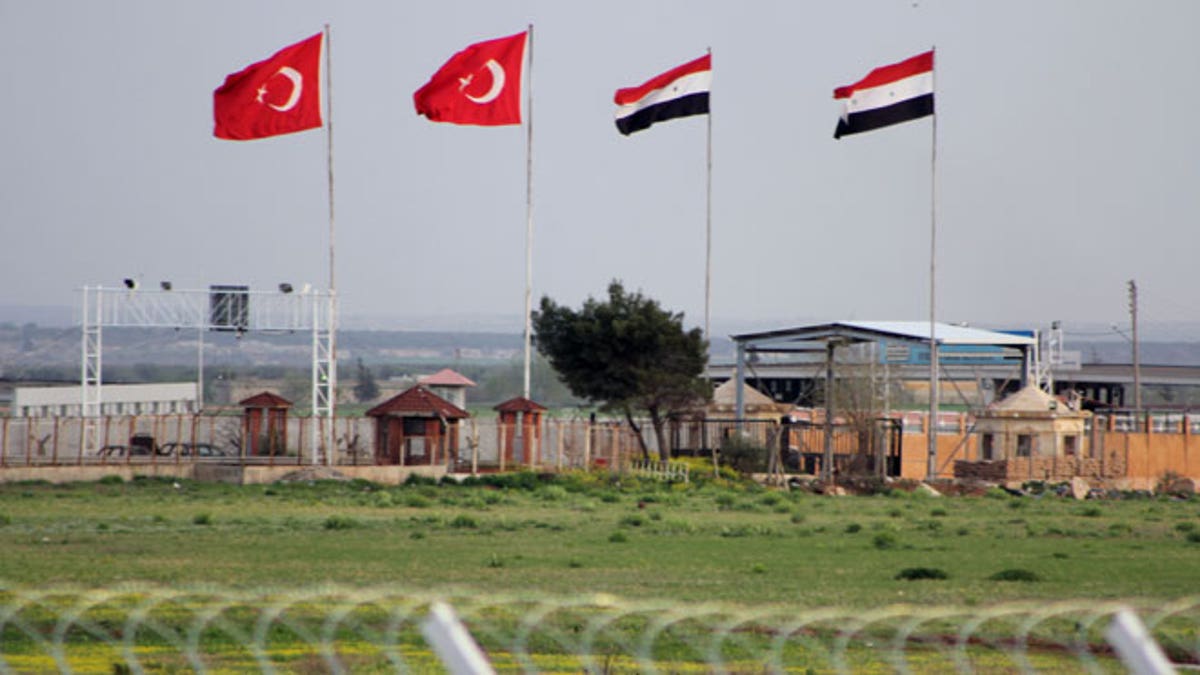
In this photo taken Tuesday, April 10, 2012, the border crossing between Turkey and Syria is seen from a refugee camp near the border, in Kilis , Turkey. (AP)
BEIRUT – A Syria cease-fire was largely holding Friday as tens of thousands of protesters poured into the streets in the first major test of the U.N.-brokered truce. Activists said regime forces fired live bullets and tear gas in some locations, killing at least five people, but stood back in other areas where demonstrators beat drums and chanted anti-regime slogans.
President Bashar Assad's forces halted the large-scale shelling attacks on opposition strongholds that have pushed the country toward civil war over the past 13 months. But security forces backed by tanks, snipers and plainclothes agents maintained an intimidating presence in the streets and scattered violence was reported.
The U.N.-Arab league envoy, Kofi Annan, hoped to dispatch an advance team of up to 30 observers to Syria as quickly as possible to start monitoring the truce, and the U.N. Security Council was to vote on his request later Friday. If the relative calm holds, a beefed-up mission of up to 250 members was to follow quickly.
But Western distrust of the regime's intentions runs deep. French President Nicholas Sarkozy told a French TV station Friday that Syria's government must be closely monitored.
"I don't believe Bashar Assad is sincere," he said. "I don't believe in the cease-fire, sadly."
The truce, which formally took effect Thursday, is at the center of Annan's six-point plan to stop the bloodshed and launch talks on Syria's political future. The uprising began in March 2011 with peaceful protests but became increasingly militarized in response to a brutal crackdown by the regime. The fighting has killed an estimated 9,000 people.
Annan spokesman Ahmad Fawzi said Friday that the peace plan has been "relatively respected."
However, the regime has ignored at least two major points in the plan -- to send forces back to their barracks and to allow peaceful demonstrations. Troops remain in towns and cities, and the regime insisted that demonstrators seek government permits.
On Friday, Syrian forces tightened security in public squares and outside mosques after opposition leaders called for widespread protests to test the regime's commitment to the Annan plan.
Tens of thousands poured into the street in cities and towns across the country after noon prayers in mosques, according to the Britain-based Syrian Observatory of Human Rights, an activist group that mains a network of monitors on the ground. The turnout was higher than in recent weeks, when a government crackdown and heavy security presence discouraged demonstrators.
Security forces fired live rounds, tear gas or beat protesters in some areas, but amateur videos showed large peaceful and seemingly cheerful anti-government rallies in other locations.
In the Damascus suburbs of Zabadani and Douma and in northern town of Idlib, large crowds linked arms and chanted anti-government slogans. In the southern city of Daraa, birthplace of the uprising, several hundred people formed rows, holding hands and dancing to the beat of a drum while chanting "Come on, Bashar, Leave!"
However, troops and pro-government militiamen known as shabiha surrounded a mosque in the Damascus neighborhood of Qadam and beat people staging a protest inside the house of worship, said the Local Coordination Committees, another activist group. In Syria's largest city, Aleppo, troops fired tear gas at marchers gathering outside the Grand Mosque, the group said.
In some areas of Damascus, the widespread deployment of plainclothes agents of the feared Mukhabarat security service limited the size of the protests, said an activist in the city, Maath al-Shami. He said many regime opponents chanted anti-government slogans inside mosques, but were unable to take their marches to the streets.
"The big security campaign succeeded in limiting the size of the protests," al-Shami said.
By mid-afternoon Friday, at least five protesters were reported killed, in what appeared to be a lower-than-usual toll for Friday marches. It is impossible to confirm casualty tolls because the country is largely sealed off from journalists.
The Observatory said two marchers were killed in the opposition stronghold of Hama as they and others tried to reach the main Assi Square, which protesters had occupied for several weeks last year. Two others were killed and 11 wounded in the southern town of Nawa when protesters came under fire from security forces as they gathered in the central square, said area activist Adel al-Omari.
The LCC put the nationwide death toll at 11 protesters.
The Syrian government has broken promises in the past and so far ignored a key provision of Annan's plan to pull troops back to barracks. Opposition leaders say Assad doesn't want to ease the clampdown -- because that would unleash protesters to flood the streets and escalate the movement to bring down the president.
Mass protests were held during the early days of the uprising, but such demonstrations have become smaller and are dispersed quickly because of the violent crackdown and heavy presence of Syrian security forces.
On the diplomatic front, Annan has urged the 15-nation U.N. Security Council to authorize an observer mission that would help keep the peace.
Ahmad Fawzi, his spokesman, said an advance team was prepared to travel to Syria quickly to prepare for a full mission of up to 250 observers on the ground. He also quoted Annan as telling the council "that we need eyes on the ground, in light of the fragile calm that appears to be prevailing. We need eyes on the ground quickly to observe and monitor the situation."
